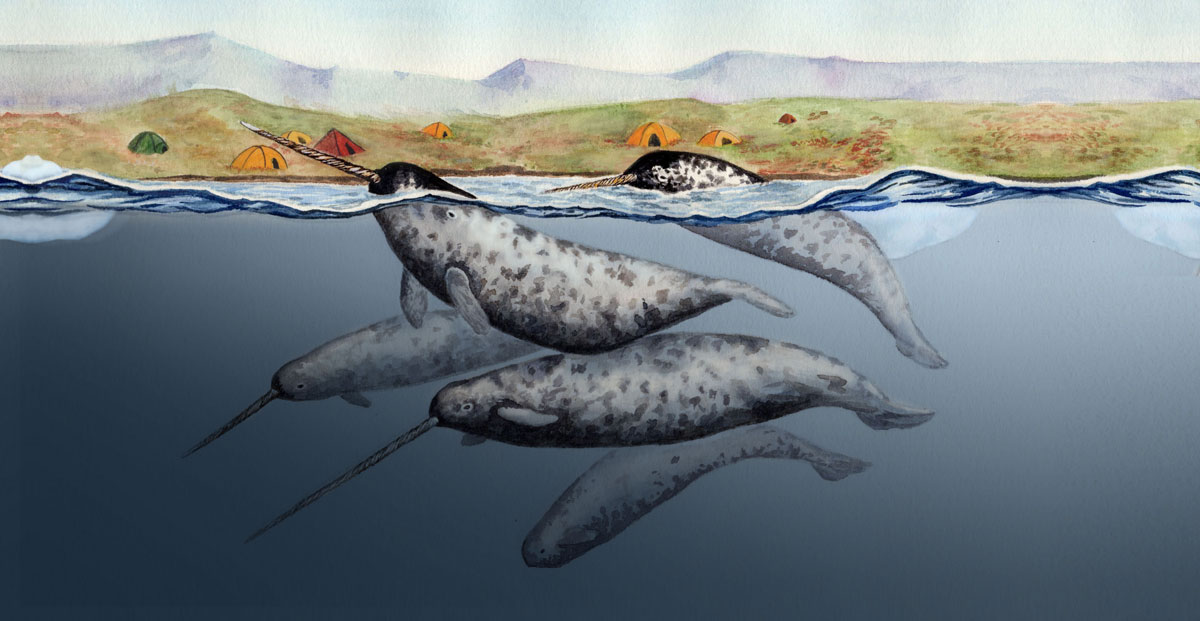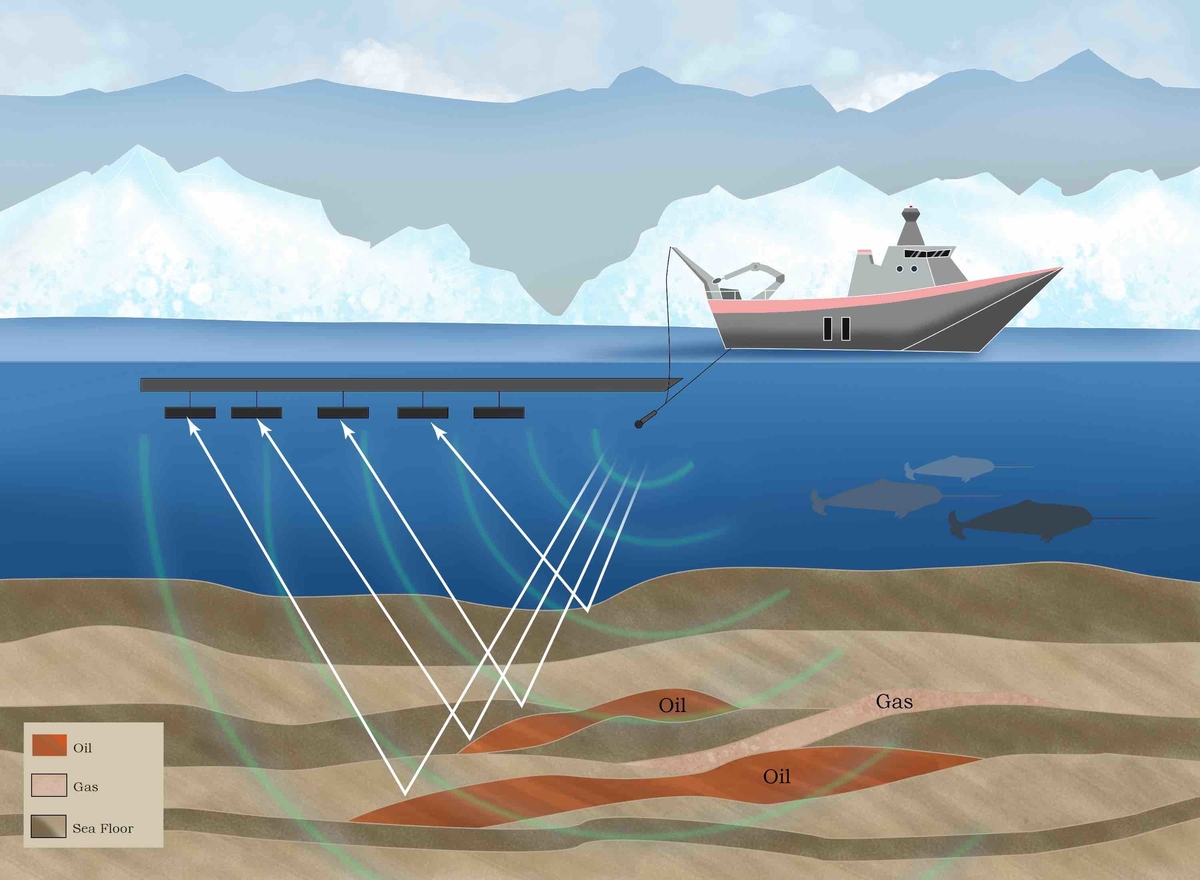How Noise Affects Greenland’s Gentle Giant
As Greenland continues losing its ice, there are plans to increase oil exploration in the Arctic. Now, a California researcher is studying how this may affect the physiology of naive narwhals, Isabella Backman reports.
Illustrations by Caitlyn Cassidy and Zia Abraham

Illustration: Caitlyn Cassidy
All is quiet in the fjord. The only sounds are the howling Arctic winds whipping through snowy peaks and the crackling of ice concealing the ocean beneath it. It is a world of ice and sky, devoid of color. With neither dirt nor the green hints of chlorophyll, the landscape is endless white and blue.
A camera sits on a stone cairn—watching, waiting for the enduring winter to give way to a mild, ephemeral summer. In what seems like a world away, California researcher Terrie Williams anxiously monitors the fjord. This relatively untouched landscape is rapidly changing, and she is concerned about the consequences for the animals that call the Arctic home.
In the summertime, a pod of narwhals will emerge from their wintering grounds and enter their seasonal residence in the fjord system. During the winter, the lack of cracks and open areas for breathing lock these deep diving cetaceans out of the icy fjord. Williams must wait for the transient window when an opening in the ice will allow her team and the animals to meet. An ecophysiologist at the University of California, Santa Cruz, she is the first to measure the physiological functions of these elusive, poorly understood creatures as their underwater home changes.
As the summer months near, the landscape begins to thaw. The ice melts and cracks, breaking off into majestic, glistening icebergs. Gradually, they are swept away by wind and sea.
In June, the fjord finally awakens from its long hibernation. The endless white is replaced with browns, greens, oranges and reds as low scrub appears on the hillside. Summer has freed the frozen fjord, and it is time for the narwhals to come feed on the fish previously locked away. Now, the researchers can set up camp.
As climate change continues to thaw the once pristine landscape, the development of new shipping routes in search of oil will expose the Arctic to more traffic than ever before. Because deep diving cetaceans like the notoriously elusive narwhal are poorly understood, researchers from all over the world are hoping to learn more about the animals and their vulnerability to the changes we create in their marine world. Now, Williams is attaching heart rate tags to narwhals to demonstrate for the first time how anthropogenic stressors such as noise pollution impact the biology of the marine mammals, which have previously been naïve to human activity. While previous studies have documented the behavioral responses of narwhals to stressful situations, her research will be the first to provide quantifiable data on the physiological consequences of stress on the deep diving cetaceans. As large numbers of whales continue to wash up on shores around the world in mysterious mass stranding events, enacting policies to protect these animals from harmful human activity is critical.
“These animals are special,” says Mikkel-Holger Sinding, a biologist who has been helping put satellite tags on narwhals for the Greenlandic Institute of Natural Resources every summer since 2014. “When you stand up close to this big white whale with a 2-meter long tusk, there is something magical about it.”
Noisy Intruders in the North
There are approximately between 100,000 and 150,000 narwhals worldwide, ranging from Canadian to Russian waters in the far north of the earth. Around 10-15% of this population is found in Greenland, which sits east of the Canadian Arctic. At up to 5 meters long, these marine mammals are a huge torpedo of muscle.
Until recently, very little was known about narwhals. Dwelling in remote icy waters, they have been living in isolation from heavy human activity. “It’s the middle of nowhere, and hardly anything lives there,” says Sinding. “And then you have these giant weirdos sliding around.”
Now, however, their home is rapidly changing. Climate change is warming the Arctic, and the sea ice is melting away at unprecedented rates. In 2008, the US Geological Survey estimated that the Arctic Circle contains almost a quarter of the planet’s undiscovered oil and gas resources. Until recent years, however, drilling in the far north has been blocked by extreme weather and sea ice. As summer sea ice declines, this region has become more accessible and attractive for offshore oil and gas exploration. In December of 2020, for example, the Trump administration overturned decades of protections while finalizing its plan to launch oil exploration in the Arctic National Wildlife Refuge. As Greenland transitions to increased economic independence from Denmark, there is growing interest within the country to generate income through non-renewable energy.
Unfortunately, seismic ships are noisy intruders. To find oil, members of the petroleum and gas industry use seismic air guns that compress air and shoot it into the sea. Then, similar to how animals use echolocation to navigate, they listen for echoes as sound bounces off of layers under the ocean floor. A line of specialized microphones attached to floating cables is towed behind the ship and detects the returning pulses. Scientistsanalyze the echoes coming back to create a 3D map of the ocean floor beneath them. These seismic blasts require high amounts of energy.
Diagram of seismic survey by Zia Abraham.
Marine mammals like narwhals live in an environment where sound is essential for their survival. They use it daily for important functions including navigation, communication and finding food.
“Their whole environment is an environment of sound as opposed to sight,” says Lei Lani Stelle, a biologist at the University of Redlands in California.
Scientists have reported that loud, unexpected sounds, like those created by seismic exploration, cause the deep diving animals to flee the area. By monitoring narwhals’ biological functions, Williams hopes to better understand how the behavioral responses to stressors like noise affect the physiological response of the animals.
“All [animals] are perfectly designed for what they need to do in order to survive in their environment,” Williams said during her public Ed Ricketts Memorial Lecture in January 2021. The question is, she continued, is that design still appropriate for all the changes humans are creating in their environment?
A Team Effort
Little tents sit along the sea in the fjord. The researchers are not working here alone—they share their camp alongside indigenous hunters. The scientists and hunters have different goals. With no grocery store around the corner, the hunters live off of the land, and narwhals are a part of their sustenance. Through a deal with the Greenlandic Institute of Natural Resources, which conducts research on Arctic ecosystems and advises Greenlandic government officials, however, the hunters are paid to let a subset of the animals be used for science.After being tagged with various instruments, these designated animals were released back into the ocean so that the scientists could study them.
“This has been one of the more amazing things in this process. I’d never worked with an animal in which I was also working side by side with a human community,” Williams said in her lecture. “There is this balance that’s going on between the hunting activities that are happening in this area and the scientific activities.”
In order to catch a narwhal, hunters deploy nets along the shore. Then, way up on the hillside above camp, they wait and watch. They may wait for hours, days or even weeks. If they miss their chance, they will have to wait a whole year for the animals to return.
One researcher at the camp, Susanna Blackwell, is a biologist for Greeneridge Sciences, an independent company specialized in assessing the effects of industrial noises. According to Blackwell, watching the hunters look for whales was very eye opening. While Blackwell needed a telescope to spot narwhals, hunters could see them with their naked eyes because, Blackwell says, “the shimmer of light on the water was a certain way.”
Now, a group of scientists guide an entangled narwhal into shallow waters. In order to stabilize the animal, four researchers stand in the ocean near the animal, two on each side, encircling the cetacean to keep it from rolling over. Although the water is up to the scientists’ chests, they keep warm in special waterproof dry suits. Still, the instruments they use require bare hands, so they work as quickly as they can with frigid fingers.
While one person holds the narwhal’s tail, the other researchers tie a soft, flat rope around it to prevent any thrashing. Once the rope is in place, the scientists remove the net and take measurements of the animal’s tusk and body. They also place several pins on the back of the animal, a process similar to ear piercing, that contain satellite tags used for tracking by the Greenlandic Institute. Despite all of this, the narwhal remains remarkably peaceful, Sinding says.
“Once they are out of the nets, they calm down,” says Sinding. “It’s surprising that a wild animal would be that calm.”
After the instruments are in place, the researchers move back from the narwhal and allow it to return to deeper waters. The animal remains docile as it swims away.
“When we release them, often they seem to be like, ‘Oh, I can go?’” says Blackwell. “It’s very low key.”
The entire process of tagging these animals, according to Williams, is an incredible experience.
“How many people in the world have ever put their hands on a live narwhal tusk?” she says.
For her own work, she is interested in quantifying the consequences of the animals’ response to anthropogenic stressors on its physiology.
“So an animal can run away, but maybe that’s not a big deal,” says Williams. “What is it that really leads to something that may be problematic with the animal’s biology?”
Finding a way to take these measurements, however, was a challenge at first.
“There’s absolutely no good way to stick a heart rate monitor on a narwhal,” she explains. Unlike other marine mammals like seals, which have fur the instruments can be glued to, tags do not easily stick to cetaceans. After some experimentation on dolphins, Williams found that the only thing that worked was using suction cups to secure instruments to cetaceans. After around four days, the cups are usually knocked off the animal. The instruments contain a floating device that carries the cups back to the surface as well as radio and satellite tags that help the researchers locate the device. With the help of the hunters’ keen eyes, Williams goes out into the sea and retrieves the instruments.
To better understand the effects of seismic exploration on narwhals, the Danish government has brought in an experimental seismic ship into Scoresby Sound, a large fjord system in east Greenland, with air guns for pulsing noise into the environment. Williams is using her instruments to monitor the cetaceans’ biological functions in response to this introduced stressor.
The Deep Divers’ Dilemma
Although the narwhals had appeared calm as they swam away from the researchers, Williams’ heart rate monitors have revealed a surprising trend. Back in her lab at Santa Cruz in 2014, Williams found that as the narwhals escaped from the researchers, their heart rates dropped as low as three to four heart beats per minute, or only one heart beat every 20 seconds. This plummet in heart rate was so drastic, she almost threw the data away.
A slowed heart rate, or brachycardia, is an evolutionary response that helps narwhals conserve oxygen. As the animals dive below the ocean surface, their heart rates drop from 60 beats per minute down to 10 to 20 This response also occurs when they escape from killer whales by swimming beneath ice cover or deeper into the water column where they need to hold their breath for longer periods of time. In contrast, when humans get scared, our heart rates speed up as our bodies go into a flight-or-fight response, preparing us to either get out of the situation or defend ourselves.
When a narwhal encounters a killer whale, its typical escape response is to escape slowly to avoid detection by predators. However, after the naïve narwhals swim away from the researchers, an unexpected escape response occurs. On top of the brachycardia, the narwhal also swims faster than normal as it flees. Rapid swimming requires more oxygen and therefore an increase in heart rate. However, the animal’s dive and fear responses are telling the heart rate to slow down. At only three to four beats per minute, the animal is at risk of receiving insufficient oxygen to its brain and organs.
Now, Williams is studying this paradoxical escape behavior in narwhals in response to seismic exploration. As the experimental seismic ship approaches Williams’ tagged narwhals, she again has observed this paradoxical physiological response. The animals flee, swimming faster than she has ever seen a narwhal swim. However, once again, their heart rates are suppressed, despite them working hard to get away. Furthermore, as they swim fast, they are unable to hold their breath and have to move to shallow water. According to Williams, ascending too quickly may put these animals at risk for decompression sickness, or the bends.
“This is the narwhal’s Achilles’ heel,” she says. “Trying to swim fast while diving is really hard on the physiological system of these animals.”
“What we knew about how mammals can function, the narwhals are pushing those boundaries,” says Sinding. “They are biomechanically unlike anything else.”
This cardiac conflict has been seen in humans, however, during triathlons. An athlete, Williams reflects on waiting for an Ironman race to begin in Couer d’Alene, Idaho. Standing on the shore, she remembers how her heart races in anticipation. When the gun goes off, she sprints into the water, moving as fast as she can to avoid getting trampled by the athletes behind her.
When athletes enter the cold water, their heart rates slow. At the same time, they are pushing their bodies to get to the front of the pack. This has led to incidences of cardiac arrest during races, and as a result, many events have transitioned from mass to controlled starts and encourage athletes to get in the water before the race.
When ships search for oil, their air guns blast over and over again. Through the collection of her heart rate monitor data, Williams hopes to better understand this conflicting physiological response that occurs while the animals flee manmade stressors and how much noise they can tolerate. As traffic in the Arctic grows, scientists worry for the fate of narwhals, including Mads Peter Heide-Jørgensen, another biologist at the Greenlandic Institute.
“If this occurs on a large scale, their body condition will deteriorate,” he says.
Championing for the Cetacean
Hundreds of pilot whales lay lifelessly on a remote beach in Tasmania. It is the worst mass stranding event Australia has ever seen. With over 300 dead, rescuers frantically work to keep survivors wet and cool while using slings to drag them back into the sea. Others, too weak to be rescued, are euthanized.
This incident, which occurred in September of last year, is not isolated. Whales are washing up dead or nearly dead in the hundreds on shorelines around the world. These mass standing events are poorly understood. The washed up whales are not suffering from disease, nor are they starving. However, rescuers have noticed that they are often disoriented and confused.
“This is the narwhal’s Achilles’ heel. Trying to swim fast while diving is really hard on the physiological system of these animals.”
“These are deep diving cetaceans we shouldn’t even see in the coastal area,” says Williams. “There is concern that these mass stranding events, or at least some of them, are related to noise.”
In order to protect cetaceans like narwhals, scientists first need to gain a better understanding of the animals and how we impact their environment. Williams hopes her findings will provide concrete guidance for setting standards in terms of what noise levels marine mammals can tolerate, how close ships can get and what areas need protection, both in the Arctic and other areas with deep-diving cetaceans. However, it will be up to individual countries’ government agencies and policy makers to decide if the physiological responses are enough to place limits on seismic exploration.
Even the experimental seismic ship, which produced noise levels only a fraction of what’s permitted in terms of oil exploration, was capable of inducing a harmful physiological response in narwhals. If she finds that seismic exploration is overall detrimental to narwhal populations, Williams hopes to eventually bring her work to DC and advocate for setting limits on oil exploration.
“It would be worth it if I felt that people are paying attention to what we are saying,” she says.
Other biologists show cautious optimism about narwhal conservation efforts. Protecting narwhals is a high priority of the Greenlandic government, which is responsible for issuing permits for seismic exploration in the Arctic, so that the animals are available for sustenance hunting. Furthermore, Moira Brown, a senior scientist at the Canadian Whale Institute who was not involved with the study, has spent much of her career working with individuals in the shipping and fishing industries that were willing to make changes to help give whales more room to live.
“I’ve never met anyone in those industries that wants to see the animals gone,” she says. “There is a lot of effort to try and figure out how humans can try and change their activities to give these animals more room to live.”
Winter Returns in the Fjord
August turns into September, summer’s colors fade back to white, and an icy blanket reclaims the sea for another long winter ahead. Another season of fieldwork has come to its conclusion, and now the researchers must wait for the fjord to allow their science to happen once again.
Back in the mild California, Williams reflects on a quote by John Steinbeck:
Men really need sea monsters in their personal oceans. An ocean without its unnamed monsters would be like a completely dreamless sleep.
Narwhals are indeed the Arctic’s sea monsters. But, she says, they are the mildest monsters she’s ever seen.
© 2021 Isabella Backman / UC Santa Cruz Science Communication Program

Isabella Backman
Author
B.S. Biology, Saint Michael’s College
Internships: NASA Ames Research Center, Stanford University, Good Times
In my junior year of college, I received a grant to work in a prestigious lab. I was finally achieving my childhood goal of becoming a scientist—or so I thought. The lab studied how rising temperatures affected intertidal organisms, including mussels, starfish and snails. Soon, however, I realized how the research was conducted: every morning, I placed snails into a giant oven and baked them to their deaths.
Sometime during my summer of snail mass murder, I decided that research wasn’t my calling. Later, while presenting my research at a conference, I realized that I enjoyed sharing my findings more than conducting the research itself. After listening to a talk by Carl Zimmer and attending a few science communication workshops, I was sold. I had found my true calling: science journalism.

Caitlyn Cassidy
Illustrator
Caitlyn Cassidy is a Washington-based science illustrator who started drawing and painting as a child. Her love for nature and marine life was nurtured through family weekend trips to the ocean and backpacking trips into the Cascade mountain range. Activities such as exploring tide pools, collecting seashells, and watching bears harvest berries along a mountain trail inspired her curiosity and a passion for nature. She hopes to use her illustrations to inspire a sense of wonder and appreciation for the natural world, and help others discover the fascinating and marvelous world we live in.
Caitlyn is currently enrolled in the CSU-Monterey Bay’s Science Illustration Program of 2020-2021.

Zia Abraham
Illustrator
B.A Geology, University of California, Davis
Internship: Smithsonian, Museum of Natural History, Entomology Department. Graphic Design, Dallas Zoo, Texas.
After graduating from the University of California, Davis with a B.A. in Geology, Zia found that her interest in science illustration would drive her to create art pieces that help relay information as well as encourage people to be more open to learn about the subjects she illustrates. With the goal of refining her skill as an artist and learning more about entomology, botany, and marine life, she aims to make realistic illustrations while maintaining a stylistic approach in hopes of sparking curiosity in those who view them. Completing her internships with the Smithsonian and Dallas Zoo will help further her goal of spreading information through the use of engaging illustrations provided to these organizations for scientific research and entertainment.

Innova Disc Golf is seeking a full-time Illustrator for our Ontario, California location. The Illustrator is integral to Innova’s disc decoration program. The primary role is to quickly and creatively take customer-supplied artwork and prepare line art for disc hot stamping based on department guidelines. Secondary duties include branding design and product photography for Innova’s digital channels. The Illustrator is highly skilled in illustration, typography, layout design, and vector graphics using Adobe Illustrator. Clear and prompt communication with the creative team and customers is essential. The Illustrator reports to the Art Director for all projects.
Location:
Remote – The Designer role is based out of our Ontario, CA office, but is a remote position, with hours between 8:00 am – 04:30 pm Pacific (Los Angeles) time, Monday through Friday
Responsibilities:
Adapt client-supplied art, finalize in black and white vector files
Work in Adobe Illustrator and Photoshop application
Contribute to a distributed creative team
Manage design tasks from conception to completion
Experience:
Ability to work on varying levels of art projects, from raster or vector digital images to napkin sketches
Strong technical skills in Illustrator and Photoshop
Must have an online portfolio for review
Strong communication skills with a distributed, remote team
Pre-press technical skills are a plus
Physical Requirements:
Work from home
Must be able to perform the above for at least 8 hours per day 5 days per week (8:00 am – 04:30 pm)
Prolonged periods sitting at a desk and working on a computer
Repeat the same movements
Equipment:
Champion Discs, Inc will provide all the equipment needed for work .
Education:
A degree in design, fine arts, or related field is a plus (preferred)
About Us :
Innova Discs is the largest and most popular manufacturer of sporting equipment for the sport of Disc Golf. We revolutionized the disc golf industry when we were founded in 1983 and continue to innovate year after year. We have built an outstanding reputation for quality service and performance that customers can rely on. We are a stable and well-respected company in our industry. If you have a positive attitude, have an excellent work ethic, are interested in joining a team of dedicated professionals, and want to make us “Your Employer of Choice” we want to talk to you!
Benefits Include:
Health Insurance: Medical, and Dental Plan
Paid Holiday, Paid Sick Days, and Paid Time Off
Supplemental Life Insurance
Retirement Saving Plan (401k)
HOW TO APPLY
We came across your portfolio through http://www.indeed.com and we would like to have a brief chat with you through our HR ICQ page for the job interview, you can download ICQ or Telegram app on your computer or smartphone from the App Store, and message the Online Recruitment Manager on ICQ or Telegram through his username ICQ:(@innova_discgolf20) Telegram: (@innova_discgolf) get started.
NOTE: Those apps are simple chat messaging platform for workers like Slack.
Angela Chandler
Human Resources
INNOVA DISC GOLF